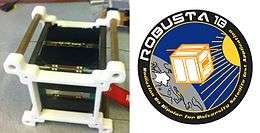ROBUSTA-1B
ROBUSTA-1B (Radiation on Bipolar Test for University Satellite Application) is a nano-satellite (Cubesat) scientific experiment developed by the University of Montpellier students, a successor to the ROBUSTA satellite, which was launched in February 2012 and lost soon after.[2]
 | |
| Mission type | Technology |
|---|---|
| Operator | Centre Spatial Universitaire Montpellier-Nîmes |
| COSPAR ID | 2017-036AD |
| SATCAT no. | 42792 |
| Mission duration | 2 years |
| Spacecraft properties | |
| Spacecraft type | 1U CubeSat |
| Launch mass | 1 kilogram (2.2 lb) |
| Start of mission | |
| Launch date | 23 June 2017[1] |
| Rocket | PSLV |
| Contractor | ISRO |
| Orbital parameters | |
| Reference system | Geocentric |
| Regime | Low Earth |
ROBUSTA-1B carries an updated version of the ROBUSTA payload, an experiment to check the deterioration of electronic components based on bipolar transistors, when exposed to in-flight space radiation. The results of the experiment will be used to validate a new radiation test method proposed by the laboratory.[3]
ROBUSTA Comparison
Started as a simple reflight of ROBUSTA,[4] the project quickly became a complete upgrade of most of the satellite's systems, using the feedback provided by the previous project [5].
References
- http://www.20minutes.fr/montpellier/2092323-20170622-montpellier-lancement-deuxieme-nanosatellite-etudiant-espace-suivre-vendredi-matin-direct
- On the (now defunct) ROBUSTA website : https://web.archive.org/web/20130814173904/http://www.ies.univ-montp2.fr/robusta/satellite/
- "The Use of a Dose-Rate Switching Technique to Characterize Bipolar Devices". Bibcode:2009ITNS...56.3347B. doi:10.1109/TNS.2009.2033686. Cite journal requires
|journal=(help) - http://space.skyrocket.de/doc_sdat/robusta.htm
- https://janus.cnes.fr/fr/JANUS/Fr/robusta-1b.htm